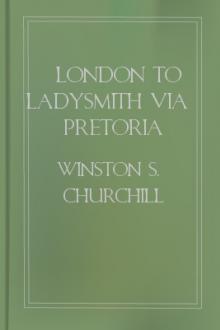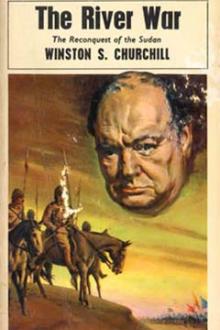London to Ladysmith via Pretoria, Winston Churchill [digital ebook reader txt] 📗

- Author: Winston Churchill
- Performer: -
Book online «London to Ladysmith via Pretoria, Winston Churchill [digital ebook reader txt] 📗». Author Winston Churchill
To what extent he was responsible for the estimates of the number of troops necessary is not known. It is certain, however, that everyone—Ministers, generals, colonists, and intelligence officers—concurred in making a most remarkable miscalculation.
It reminds me of Jules Verne's story of the men who planned to shift the axis of the earth by the discharge of a great cannon. Everything was arranged. The calculations were exact to the most minute fraction. The world stood aghast at the impending explosion. But the men of science, whose figures were otherwise so accurate, had left out a nought, and their whole plan came to nothing. So it was with the British. Their original design of a containing division in Natal, and an invading army of three divisions in the Free State, would have been excellent if only they had written army corps instead of division.
Buller found himself confronted with an alarming and critical situation in Natal. Practically the whole force which had been deemed sufficient to protect the Colony was locked up in Ladysmith, and only a few line of communication troops stood between the enemy and the capital or even the seaport. Plainly, therefore, strong reinforcements—at least a division—must be hurried to Natal without an hour's unnecessary delay.
When these troops were subtracted from the forces in the Cape Colony all prospect of pursuing the original plan of invading the Free State was destroyed. It was evident that the war would assume dimensions which no one had ever contemplated.
The first thing to be done therefore was to grapple with the immediate emergencies, and await the arrival of the necessary troops to carry on the war on an altogether larger scale. Natal was the most acute situation. But there were others scarcely less serious and critical. The Cape Colony was quivering with rebellion. The Republican forces were everywhere advancing. Kimberley and Mafeking were isolated. A small British garrison held a dangerous position at Orange River bridge. Nearly all the other bridges had been seized or destroyed by rebels or invaders.
From every quarter came clamourings for troops. Soldiers were wanted with vital need at Stormberg, at Rosmead Junction, at Colesberg, at De Aar, but most of all they were wanted in Natal—Natal, which had been promised protection 'with the whole force of the Empire,' and which was already half overrun and the rest almost defenceless. So the army corps, which was to have marched irresistibly to Bloemfontein and Pretoria, had to be hurled into the country—each unit as it arrived—wherever the need was greatest where all were great.
Sir Redvers Buller, thus assailed by the unforeseen and pressed on every side, had to make up his mind quickly. He looked to Natal. It was there that the fiercest fighting was in progress and that the strength and vigour of the enemy was apparently most formidable. He had always regarded the line of the Tugela as the only defensive line which British forces would be strong enough to hold, and had recorded his opinion against placing any troops north of that river.
In spite of this warning Ladysmith had been made a great military depot, and had consequently come to be considered a place of primary importance. It was again a question of balancing drawbacks. Buller therefore telegraphed to White asking him whether he could entrench and maintain himself pending the arrival of reinforcements. White replied that he was prepared to make a prolonged defence of Ladysmith. To this proposal the General-in-chief assented, observing only 'but the line of the Tugela is very tempting.'
General Buller's plan now seems to have been briefly as follows: First, to establish a modus vivendi in the Cape Colony, with sufficient troops to stand strictly on the defensive; secondly, to send a strong force to Natal, and either restore the situation there, or, failing that, extricate Sir George White so that his troops would be again available for the defence of the Southern portion of the Colony; thirdly, with what was left of the army corps—no longer strong enough to invade the Free State—to relieve Kimberley; fourthly, after settling Natal to return with such troops as could be spared and form with reinforcements from home a fresh army to carry out the original scheme of invading the Free State.
The defect in this plan was that there were not enough troops to carry it out. As we had underestimated the offensive vigour which the enemy was able to develop before the army could reach South Africa, so now we altogether miscalculated his extraordinary strength on the defensive. But it is impossible to see what else could have been done, and at any rate no one appreciated the magnitude of the difficulties more correctly than Sir Redvers Buller. He knew Northern Natal and understood the advantages that the Boers enjoyed among its mountains and kopjes.
On one occasion he even went so far as to describe the operation he had proposed as a 'forlorn hope,' so dark and gloomy was the situation in South Africa during the first fortnight in November. It was stated that the General was ordered by the War Office to go to Natal, and went there against his own will and judgment. This, however, was not true; and when I asked him he replied: 'It was the most difficult business of all. I knew what it meant, and that it was doubtful whether we should get through to Ladysmith. I had not the nerve to order a subordinate to do it. I was the big man. I had to go myself.'
What followed, with the exception of the battle of Colenso, our first experience of the Boer behind entrenchments, has been to some extent described in these letters. Viewed in the light of after knowledge it does not appear that the holding of Ladysmith was an unfortunate act.
The flower of the Boer army was occupied and exhausted in futile efforts to take the town and stave off the relieving forces. Four precious months were wasted by the enemy in a vain enterprise. Fierce and bloody fighting raged for several weeks with heavy loss to both sides, but without shame to either. In the end the British were completely victorious. Not only did their garrison endure famine, disease, and bombardment with constancy and composure and repel all assaults, but the soldiers of the relief column sustained undismayed repeated disappointments and reverses, and finally triumphed because through thick and thin they were loyal to their commander and more stubborn even than the stubborn Dutch.
In spite of, perhaps because of, some mistakes and many misfortunes the defence and relief of Ladysmith will not make a bad page in British history. Indeed it seems to me very likely that in future times our countrymen will think that we were most fortunate to find after a prolonged peace leaders of quality and courage, who were moreover honourable gentlemen, to carry our military affairs through all kinds of difficulties to a prosperous issue; and whatever may be said of the generals it is certain that all will praise the enduring courage of the regimental officer and the private soldier.
End of the Project Gutenberg EBook of London to Ladysmith via Pretoria
by Winston Spencer Churchill
*** END OF THIS PROJECT GUTENBERG EBOOK LONDON TO LADYSMITH VIA PRETORIA ***
***** This file should be named 14426-h.htm or 14426-h.zip *****
This and all associated files of various formats will be found in:
http://www.gutenberg.net/1/4/4/2/14426/
Produced by Steven Gibbs and the PG Online Distributed Proofreading Team
Updated editions will replace the previous one--the old editions
will be renamed.
Creating the works from public domain print editions means that no
one owns a United States copyright in these works, so the Foundation
(and you!) can copy and distribute it in the United States without
permission and without paying copyright royalties. Special rules,
set forth in the General Terms of Use part of this license, apply to
copying and distributing Project Gutenberg-tm electronic works to
protect the PROJECT GUTENBERG-tm concept and trademark. Project
Gutenberg is a registered trademark, and may not be used if you
charge for the eBooks, unless you receive specific permission. If you
do not charge anything for copies of this eBook, complying with the
rules is very easy. You may use this eBook for nearly any purpose
such as creation of derivative works, reports, performances and
research. They may be modified and printed and given away--you may do
practically ANYTHING with public domain eBooks. Redistribution is
subject to the trademark license, especially commercial
redistribution.
*** START: FULL LICENSE ***
THE FULL PROJECT GUTENBERG LICENSE
PLEASE READ THIS BEFORE YOU DISTRIBUTE OR USE THIS WORK
To protect the Project Gutenberg-tm mission of promoting the free
distribution of electronic works, by using or distributing this work
(or any other work associated in any way with the phrase "Project
Gutenberg"), you agree to comply with all the terms of the Full Project
Gutenberg-tm License (available with this file or online at
http://gutenberg.net/license).
Section 1. General Terms of Use and Redistributing Project Gutenberg-tm
electronic works
1.A. By reading or using any part of this Project Gutenberg-tm
electronic work, you indicate that you have read, understand, agree to
and accept all the terms of this license and intellectual property
(trademark/copyright) agreement. If you do not agree to abide by all
the terms of this agreement, you must cease using and return or destroy
all copies of Project Gutenberg-tm electronic works in your possession.
If you paid a fee for obtaining a copy of or access to a Project
Gutenberg-tm electronic work and you do not agree to be bound by the
terms of this agreement, you may obtain a refund from the person or
entity to whom you paid the fee as set forth in paragraph 1.E.8.
1.B. "Project Gutenberg" is a registered trademark. It may only be
used on or associated in any way with an electronic work by people who
agree to be bound by the terms of this agreement. There are a few
things that you can do with most Project Gutenberg-tm electronic works
even without complying with the full terms of this agreement. See
paragraph 1.C below. There are a lot of things you can do with Project
Gutenberg-tm electronic works if you follow the terms of this agreement
and help preserve free future access to Project Gutenberg-tm electronic
works. See paragraph 1.E below.
1.C. The Project Gutenberg Literary Archive Foundation ("the Foundation"
or PGLAF), owns a compilation copyright in the collection of Project
Gutenberg-tm electronic works. Nearly all the individual works in the
collection are in the public domain in the United States. If an
individual work is in the public domain in the United States and you are
located in the United States, we do not claim a right to prevent you from
copying, distributing, performing, displaying or creating derivative
works based on the work as long as all references to Project Gutenberg
are removed. Of course, we hope that you will support the Project
Gutenberg-tm mission of promoting free access to electronic works by
freely sharing Project Gutenberg-tm works in compliance with the terms of
this agreement for keeping the Project Gutenberg-tm name associated with
the work. You can easily comply with the terms of this agreement by
keeping this work in the same format with its attached full Project
Gutenberg-tm License when you share it without charge with others.
1.D. The copyright laws of the place where you are located also govern
what you can do with this work. Copyright laws in most countries are in
a constant state of change. If you are outside the United States, check
the laws of your country in addition to the terms of this agreement
before downloading, copying, displaying, performing, distributing or
creating derivative works based on this work or any other Project
Gutenberg-tm work. The Foundation makes no representations concerning
the copyright status of any work in any country outside the United
States.
1.E. Unless you have removed all references to Project Gutenberg:
1.E.1. The following sentence, with active links to, or other immediate
access to, the full Project Gutenberg-tm License must appear prominently
whenever any copy of a Project Gutenberg-tm work (any work on which the
phrase "Project Gutenberg" appears, or with which the phrase "Project
Gutenberg" is associated) is accessed, displayed, performed, viewed,
copied or distributed:
This eBook is for the use of anyone anywhere at no cost and with
almost no restrictions whatsoever. You may copy





Comments (0)